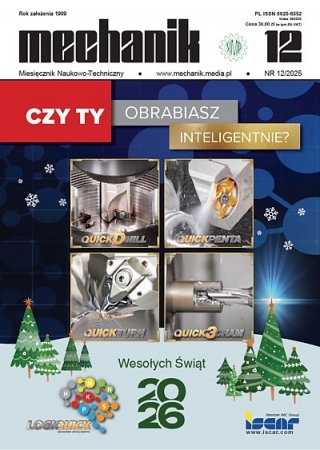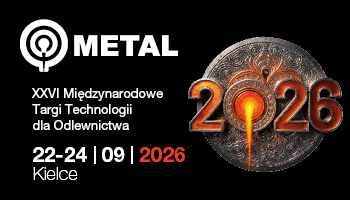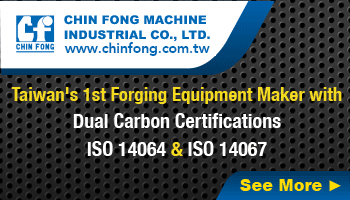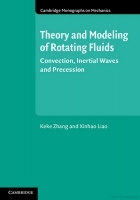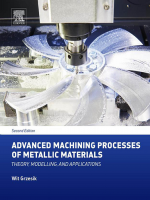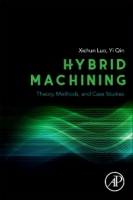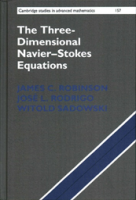Numerical analysis of the cross rolling process of a hollow railway axle
Analiza numeryczna procesu walcowania poprzecznego drążonej osi kolejowej *
Author: Zbigniew Pater
Mechanik nr 08/09/2020 - CAD/CAM/CAE
ABSTRACT: Presented is an innovative method of manufacturing hollow railway axle using three rolls. The novelty of the solution consists of the simultaneous forming of the hollow axle by three tools, which allows to quickly remove ovalisation of the cross-section of the workpiece. The correctness of the proposed solution was verified using numerical simulation. The influence of the rollers’ rotational speed on the forming process was analysed. The shape progression of the formed hollow axle, the effective strain, temperature and damage function distributions are presented. It is also shown how the force and torque on the rollers change during the rolling process.
KEYWORDS: cross rolling, hollow railway axle, FEM
STRESZCZENIE: Przedstawiono innowacyjną metodę wytwarzania osi kolejowych z użyciem trzech walców. Nowość rozwiązania polega na jednoczesnym kształtowaniu drążonej osi przez trzy narzędzia, co pozwala na szybkie usunięcie owalizacji przekroju poprzecznego obrabianego elementu. Proponowane rozwiązanie sprawdzono w symulacji numerycznej. Przeanalizowano wpływ prędkości obrotowej walców na przebieg kształtowania. Przedstawiono geometrię ukształtowanej drążonej osi, rozkłady intensywności odkształcenia, temperatury oraz funkcji zniszczenia. Pokazano również, jak w trakcie kształtowania zmieniają się siła i moment obrotowy na walcach.
SŁOWA KLUCZOWE: walcowanie poprzeczne, drążona oś kolejowa, MES
BIBLIOGRAFIA / BIBLIOGRAPHY:
[1] Shu X., Wei X., Li C., Hu Z. “The influence rules of stressabout technical parameters on synchronous rolling railwayaxis with multi-wedge cross-wedge rolling”. Appl.Mech. Mater. 37–38 (2010): 1482–1488, https://doi.org/10.4028/www.scientific.net/AMM.37-38.1482.
[2] Xu C., Shu X. “Influence of process parameters on the formingmechanics parameters of the three-roll skew rollingforming of the railway hollow shaft with 1:5”. Metalurgija.57, 3 (2018): 153–156.
[3] Romanenko V.P., Stepanov P.P., Kriskovich S.M. “Productionof hollow railroad axles by screw piercing and radialforging”. Metallurgist. 61, 9–10 (2018): 873–877, https://doi.org/10.1007/s11015-018-0579-0.
[4] Hu B., Shu X., Yu P., Peng W. “The strain analysis at thebroadening stage of the hollow railway axle by multiwedgecross wedge rolling”. Appl. Mech. Mater. 444–495(2014): 457–460, https://doi.org/10.4028/www.scientific.net/AMM.494-495.457.
[5] Peng W., Zheng S., Chiu Y., Shu X., Zhan L. “Multi-wedgecross wedge rolling process of 42CrMo4 large and longhollow shaft”. Rare Metal Mat. Eng. 45, 4 (2016): 836–842,https://doi.org/10.1016/S1875-5372(16)30084-4.
[6] Zheng S., Shu X., Han S., Yu P. “Mechanism and force-energyparameters of a hollow shaft’s multi-wedge synchrostepcross-wedge rolling”. J. Mech. Sci. Technol. 33, 5 (2019):1–10, https://doi.org/10.1007/s12206-019-0411-1.
[7] Pater Z., Lis K., Walczuk-Gągała P. “Numerical analysis ofthe cross-wedge of hollow rail axle”. Advances in Scienceand Technology Research Journal. 14, 1 (2020): 145–153,https://doi.org/10.12913/22998624/115513.
[8] Pater Z., Gontarz A., Tomczak J., Bulzak T. “Producing hollowdrive shafts by rotary compression”. Arch. Civ. Mech.Eng. 15, 4 (2015): 917–924, https://doi.org/10.1016/j.acme.2014.10.002.
[9] Tomczak J., Pater Z., Bulzak T. “Effect of technological parameterson the rotary compression process”. Eksploat.Niezawodn. 15, 3 (2013): 279–283.
[10] Tomczak J., Pater Z., Bulzak T. “The influence of hollowbillet thickness in rotary compression”. Int J Adv ManufTechnol. 82 (2016): 1281–1291, https://doi.org/10.1007/s00170-015-7437-z.
[11] Tomczak J. „Studium procesów obciskania obrotowego odkuwekdrążonych”. Lublin: Wyd. Politechniki Lubelskiej,2016.
[12] Pater Z., Tomczak J., Bulzak T. “Rotary compression asa new calibration test for prediction of a critical damagevalue”. Journal of Materials Research and Technology.9, 3 (2020): 5487–5498, https://doi.org/10.1016/j.jmrt.2020.03.074.
DOI: https://doi.org/10.17814/mechanik.2020.8-9.15
* Artykuł recenzowany



